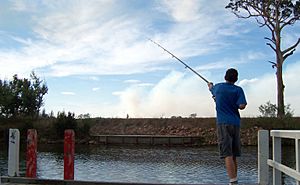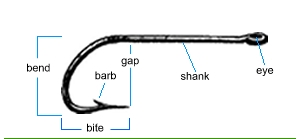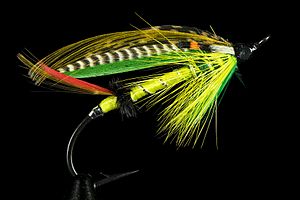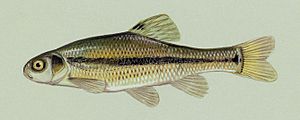Angling facts for kids
Angling is a fun way to catch fish using a special tool called a "fish hook." This hook is usually tied to a fishing line. The line is often connected to a fishing rod, which helps you cast the line out. Many fishing rods also have a fishing reel. This reel helps you store, pull in, and let out the fishing line. To attract fish, you can put lures or bait on the hook.
Angling is the main way people do sport fishing, which is fishing for fun. Some businesses also use angling to catch fish for sale. More and more people who fish for fun like to practice Catch and release fishing. This means they let the fish go back into the water after catching them.
Contents
What is a Fishing Hook?
A fishing hook is a very old tool! Long ago, people used something called a "gorge." A gorge was a thin piece of bone or stone tied in the middle to a line. People would put bait on it. When a fish or animal swallowed the bait, a tug on the line would make the gorge turn sideways. This would catch it in the animal's throat.
Today's fishing hooks are shaped like a "J" and are made of wire. They have a loop on one end to tie the line and a sharp point on the other. Most hooks have a small barb near the point. This barb helps stop the fish from getting off the hook while you reel it in. However, some places have rules that say hooks must be barbless. This helps protect fish, especially if the hook accidentally goes into their gills, which could hurt them badly.
Types of Baits for Angling
When you go fishing, the type of bait you choose often depends on the kind of fish you want to catch and where they live. Angling generally uses two main types of bait: artificial baits or natural baits.
Artificial Baits
Many anglers prefer to use lures. These are man-made baits designed to make fish bite. Artificial baits might look like real prey, or they might just have a shape and color that attracts fish. Sometimes, you need to move the lure in a special way to make it look alive. For example, in fly fishing, you use light lures called "flies" that look like insects. A common way to fish with soft plastic worms is called the Texas Rig.
Natural Baits
Natural bait anglers usually use something that the fish would naturally eat. This bait can be alive or dead. Some common natural baits for both fresh and saltwater fishing include worms, leeches, minnows, frogs, salamanders, octopus, squid, insects, and even prawns. Natural baits work well because they have the real feel, smell, and color that fish recognize.
The common earthworm is a very popular bait for freshwater fishing. Small grubs and maggots are also great for catching trout. Grasshoppers, bees, and even ants can be used for trout during certain seasons. Some anglers believe that trout or salmon roe (fish eggs) are the best bait of all. In warmer places like Florida, fish such as sunfish will even eat small balls of bread bait.
Keeping Ecosystems Healthy
It's important to be careful when using bait fish because they can sometimes spread harmful germs or organisms between different ecosystems. This can put other fish and the environment at risk. For example, some places have rules to prevent the spread of fish diseases like viral hemorrhagic septicemia. Also, it's generally advised not to use trout or salmon as bait because they can carry a disease called Myxobolus cerebralis (whirling disease).
Anglers can help prevent contamination by not dumping leftover bait into fishing spots. Also, collecting or using bait improperly can cause problems. Moving fish from one place to another can sometimes be against the law and might introduce fish that don't belong in that ecosystem. Always check local rules and be responsible to protect our waters!
Images for kids
-
An angler on the Kennet and Avon Canal, England, with his fishing tackle.
-
An angler is fishing in the middle of the river when the water is receding in Central Java, Indonesia
-
Angling at Shihtiping in Taiwan
See also
 In Spanish: Pesca con caña para niños
In Spanish: Pesca con caña para niños











